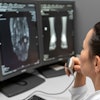VIENNA - An aging population and falling government healthcare budgets are forcing hospital administrators to figure out how to improve the performance of their facilities with fewer resources, according to a presentation at the 2009 European Congress of Radiology (ECR).
Niall Dickson, chief executive of a London-based charitable organization and think tank, the King's Fund, captured the challenge of running a European hospital in today's environment: "It's like sitting in the cockpit, flying a plane, except the control wires are crossed -- you take one action, and something else happens you weren't expecting." Dickson spoke in a symposium on hospital administration on Saturday.
In this climate of reduced healthcare budgets, increasing numbers of patients, and an aging and expensive-to-treat population, hospitals across Europe are feeling increased pressure to perform ... and to measure that performance effectively.
"Why is hospital performance important?" Dickson asked. "Europe spends a lot of money on healthcare -- it counts for the largest part of GDP spending in many [Organisation for Economic Co-operation and Development (OECD)] countries. However, with falling budgets, fewer beds, and more patients requiring hospital care, there is immense pressure on performance and efficiency."
According to Dickson, the key drivers of this pressure are:
- The aging population -- more older people living longer with comorbidities and dementia, increasing social care and medical costs
- Current lifestyles -- sedentary habits, poor diet, and smoking
- Disease profiles -- cancer has become a chronic disease, as well as an acute condition
- Society's expectations -- people don't accept perceived disinterest or poor, inconvenient service by the healthcare system
- Medical innovation, which increases costs
- IT advances, which also increase costs
- Health inequalities
- Workforce demands of better work/life balance -- the European Union's Working Time Directive limits doctors' hours
Using the English National Health Service (NHS) as an example, Dickson suggested several measures to deal with the "target-driven society." These include government targets (e.g., to reduce waiting lists) plus new targets (e.g., patient-reported outcome measures, reduced cancer deaths).
To answer these challenges, he offered the following suggestions for hospital and healthcare managers:
- Make hard decisions in this new low-money/high-demand era.
- Avoid "short-termism" (do not remove management tiers).
- Redesign services to be more efficient.
- Value clinical leadership.
- Focus on hospital services, not buildings.
"With the right approach, it is possible to do more for less," he concluded.
By Rob Skelding
AuntMinnie.com contributing writer
March 8, 2009
Related Reading
Report: Hospitals hit by capital crunch, February 2, 2009
Survey forecasts drop in capital purchasing, December 18, 2008
Pay-for-performance has little effect on hospitals' quality of care, June 6, 2007
U.K. hospitals could close under NHS reforms, August 18, 2006
Copyright © 2009 AuntMinnie.com



















